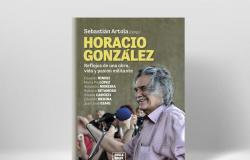Maribel Riaza has written a history of reading that answers questions of this type: Why was it read aloud in the past? What is our brain more prepared for: listening or reading? What will the reading of the future be like? These and other questions find answers in a volume full of curiosities.
In this making of, Maribel Riaza tells the origin of The voice of the books (Aguilar).
***
Once upon a time. An amphora from 480 BC kept in the British Museum in London represents the figure of a man standing on a pedestal, dark-skinned, with curly hair, a bushy beard and wrapped in a toga that leaves his shoulder exposed. If we look closely, some words come out of his mouth in the form of a “sandwich” in which we can read “Once upon a time in Tirins…”. “Once upon a time”, how many times have we heard and uttered these words ourselves? It impresses me that after more than 2,500 years, generation after generation we continue to start stories with the same formula. Because stories were born since we existed as a species, it is something intrinsic to our nature, and they existed even before books were invented, it is the voice of books.
The idea of writing about how we have enjoyed the stories came from my professional experience. I started working in the audiobook sector almost eight years ago when I had the opportunity to collaborate with Storytel, the first audiobook platform: recordings of reading aloud carried out by professionals and thanks to which we can enjoy books at their own pace. all hours of the day. Then I realized that listening to others read aloud was not something new, but in reality it is how it has been read throughout our history.. We have so internalized that reading means doing it in silence and alone that we think it has always been like this and it turns out that, depending on the countries or social classes to which we refer, it is something that in an extensive and majority way only has a few centuries of life. The usual thing was to read out loud and in the company of others.
“In this case we have not had to go excavate in the ground but to read texts from each of the periods very carefully.“
The book takes a historical tour and we discovered that in Antiquity reading was another social event, or how in the monasteries of the Middle Ages it was read during meals or in the Renaissance there was the figure of “his majesty’s reader.” This is a practice that will survive until the 20th century. XX where we know how it was read aloud in the tobacco factories of Cuba, where each of the workers contributed part of their salary so that another would be free to read aloud to them.
During these years of research I have felt like a kind of “archaeologist of the spoken word.” We can know what the houses were like in Roman times because Vesuvius left Pompeii buried with lava, and today we can see what the layout of the houses was like or what vessels were used, but how do we know how it was read? In this case we have not had to go excavate in the ground but rather read texts from each of the periods very carefully.
“All these tests and many more are what have led experts to affirm that the usual way of reading was to do it out loud.“
For example, the Roman Pliny the Younger made a copy of all the correspondence he sent throughout his life and thanks to them today we can learn what daily life was like in 1st century Rome and, among other things, know how it was read, because he tells us. For example, he tells us that when he ate with his wife or friends he liked them to read a book aloud to him. The silence and solitude of hunting were conducive to study and reading, so it was advisable to always carry some tablets to read.. Also, at parties it was common to entertain guests with readings.
Experts on the Spanish Golden Age have also found many examples in which the authors address the readers directly and also do not call them readers but “listeners”, because that is how they were going to know the story, by listening to it. For example in The search from Quevedo we read “Listener, if you help me, with your malice and laughter, I will tell truths in my shirt, almost naked.”. And in Don Quixote there are many examples where we can learn how it was read at this time. We not only see it in the different characters, from Alonso Quijano who reads alone and in silence, to the priest who reads aloud to others, to Sancho Panza who tells stories orally. All this evidence and many more are what have led experts to affirm that the usual way of reading was to do it aloud.
“In many cases, being a topic that has only been briefly discussed in books on reading, bookstores or libraries, much of the information was at the bottom of the page or was a clue that directed me to another place.“
But I didn’t want to write a book for philologists but to explain in a pleasant and simple way why it was read aloud, what the reasons were, how this changed and what effect it even had on political, social and religious movements. For this reason, I have recreated scenes in which people from different historical stages appear reading and sharing reading with others, from prehistoric caves to how we do it today, when, for example, we read a story to a child. Once each of the scenes has been presented, I go on to explain the causes or reasons why this was the case, emphasizing anecdotes or curiosities (of which there are many!) that accompany this matter. Thus, the reader will be able to access a linear, historical exhibition that mixes narrative parts and informative parts, all built in small fragments with a title that refers to its content, but which can also be accessed independently, without the need to follow the established order. For this part I had to access a multitude of scientific studies, books, articles that are duly registered in the bibliography. In many cases, as it is a topic that has only been briefly discussed in books about reading, bookstores or libraries, much of the information was at the bottom of the page or was a clue that directed me to another place.
The second part of the book refers to reading aloud today, for which the work methodology has changed. In this section I had to resort to conversations and interviews with various people who showed me their way of enjoying reading in the company of others. Finally, there is an appendix where references in literature and cinema have been included that show that reading aloud has actually been prevalent throughout our history.. In the first drafts, these examples were mixed with recreations and historical explanation, but it was decided to bring them to the end to clearly differentiate which documents were evidence that certified what we were trying to convey (among which there are works such as Don Quixote) and which They were artistic works that had been created outside of their historical moment and although they captured very well what was happening, they cannot be considered a testimony that the reading occurred that way.
“We are a society that has so internalized that reading is something individual and that develops in silence that we considered it important to show paintings or other representations that showed the reality of each moment.“
Of course, the objective of talking about how humanity has read throughout its history is so vast that even in the more than 400 pages that the book has, it does not fit and part of the difficulty was in deciding what was being referred to. and what was left out.
Finally, a very important part of the creative process was the selection of photographs that the book includes and that show paintings from all periods where people appear reading out loud in company and that served to illustrate the main message that we wanted to convey. We are a society that has so internalized that reading is something individual and that takes place in silence, that we considered it important to show paintings or other representations that showed the reality of each moment and where shared reading was included.
—————————————
Author: Maribel Riaza. Qualification: The voice of the books. Editorial: Aguilar. Sale: All your books.
5/5
(2 Ratings. Rate this article, please)






